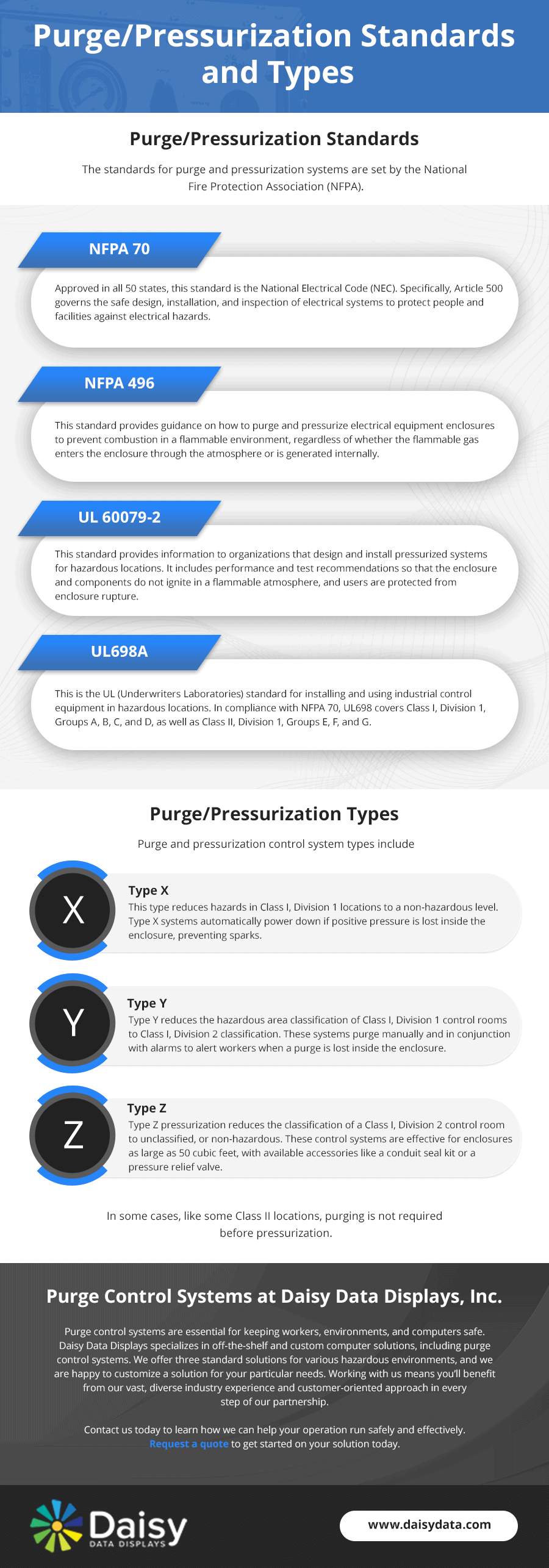Purge Systems and Controls 101
Purging is the process of supplying instrument-grade compressed air or inert gas into an enclosed piece of equipment, such as a computer, to reduce the level of hazardous gas inside the enclosure. Purge control systems use clean air to flush out hazardous or combustible gas and dust from the enclosure, panel, or motor housing. The enclosure is then pressurized to maintain the level of inert gas. This process allows for the safe operation of any electronic equipment in an enclosed space, even if that equipment is not specifically approved for hazardous conditions.
Although it is true that we need to protect computers from their environment, we also need to protect the environment from computers. For this reason, computers must be purged periodically using effective purge control systems. Here we’ll discuss the standards that dictate purging and pressurization, as well as the benefits and applications of these procedures.
Purge/Pressurization Standards and Types
The standards for purge and pressurization systems are set by the National Fire Protection Association (NFPA).
NFPA 70
Approved in all 50 states, this standard is the National Electrical Code (NEC). Specifically, Article 500 governs the safe design, installation, and inspection of electrical systems to protect people and facilities against electrical hazards.
NFPA 496
This standard provides guidance on how to purge and pressurize electrical equipment enclosures to prevent combustion in a flammable environment, regardless of whether the flammable gas enters the enclosure through the atmosphere or is generated internally.
ISA 12.4-1996
This standard provides information to organizations that design and install pressurized systems for hazardous locations. It includes performance and test recommendations so that the enclosure and components do not ignite in a flammable atmosphere, and users are protected from enclosure rupture.
UL698A
This is the UL (Underwriters Laboratories) standard for installing and using industrial control equipment in hazardous locations. In compliance with NFPA 70, UL698 covers Class I, Division 1, Groups A, B, C, and D, as well as Class II, Division 1, Groups E, F, and G.
Purge and pressurization control system types include:
- Type X: This type reduces hazards in Class I, Division 1 locations to a non-hazardous level. Type X systems automatically power down if positive pressure is lost inside the enclosure, preventing sparks.
- Type Y: Type Y reduces the hazardous area classification of Class I, Division 1 control rooms to Class I, Division 2 classification. These systems purge manually and in conjunction with alarms to alert workers when a purge is lost inside the enclosure.
- Type Z: Type Z pressurization reduces the classification of a Class I, Division 2 control room to unclassified, or non-hazardous. These control systems are effective for enclosures as large as 50 cubic feet, with available accessories like a conduit seal kit or a pressure relief valve.
In some cases, like some Class II locations, purging is not required before pressurization.
Benefits of Purge and Pressurization
Purging not only removes existing gases from a system to prevent reactions with new gases, but it also removes impurities before introducing pure gas to the system. Purge control systems are also often a cost-effective solution compared to other available protection methods.
Purge and pressurization allow general-purpose equipment to be used in hazardous environments and reducethe need for heavy-duty, explosion-proof enclosures. Multiple enclosures can be protected with a single purge unit, which is easy to install and integrate into any existing enclosures.
Purge Control Systems Applications and Industries
Industries that require gas exchange or oxidation prevention rely on enclosure purge systems, which prevent contamination and explosion. Some of these industries and applications include:
- Food processing: Food-grade nitrogen and other inert gases inhibit the effects of oxidation on food and drink products, preserving food quality for as long as possible.
- Oil & gas: The rugged computers used to operate exploration rigs, refineries, and pipelines must be able to withstand vibrations, sunlight, water, dirt, and debris resulting from drilling and mining. Purging these computers eliminates the risk of sparks when operating in hazardous conditions.
- Flavor & fragrance production: Inert gas purging safely and precisely keeps flavors and fragrances pure.
- Life sciences: Purge panels help robotic arms located in hazardous areas operate safely.
- Chemical: Oxygen-sensitive processes in chemical and petrochemical manufacturing require oxygen-deficient environments to ensure the integrity of final products.
- Packaging: Purging techniques are used to displace oxygen from storage containers to improve shelf life.
Purge Control Systems at Daisy Data Displays, Inc.
Purge control systems are essential for keeping workers, environments, and computers safe. Daisy Data Displays specializes in off-the-shelf and custom computer solutions, including purge control systems. We offer three standard solutions for various hazardous environments, and we are happy to customize a solution for your particular needs. Working with us means you’ll benefit from our vast, diverse industry experience and customer-oriented approach in every step of our partnership.
Contact us today to learn how we can help your operation run safely and effectively. Request a quote to get started on your solution today.


